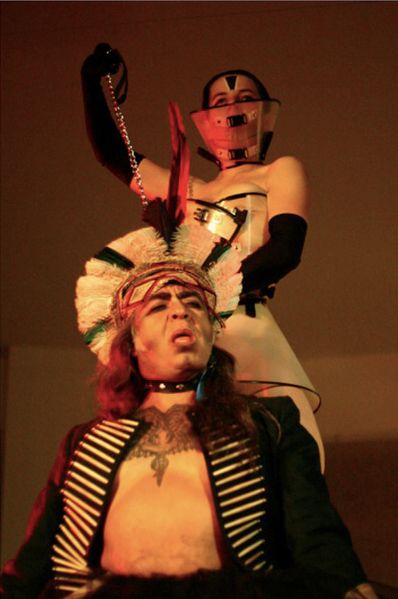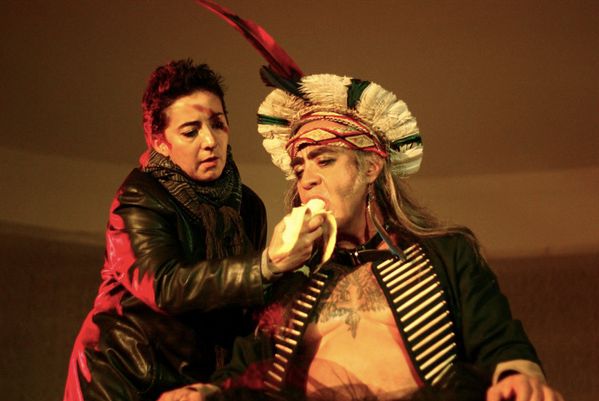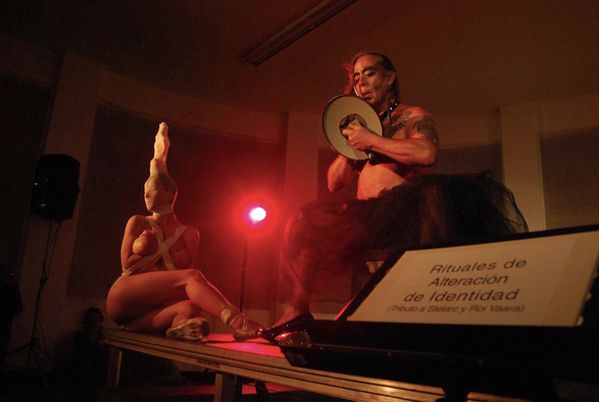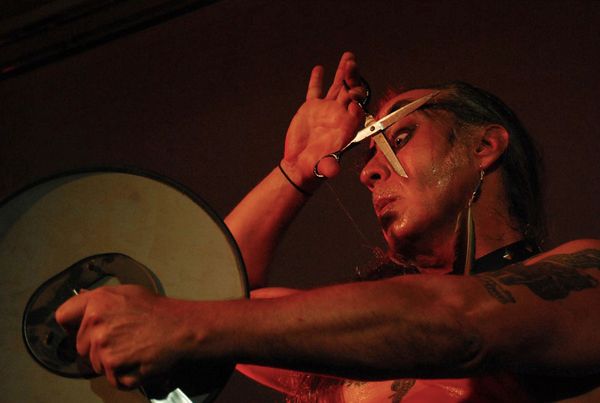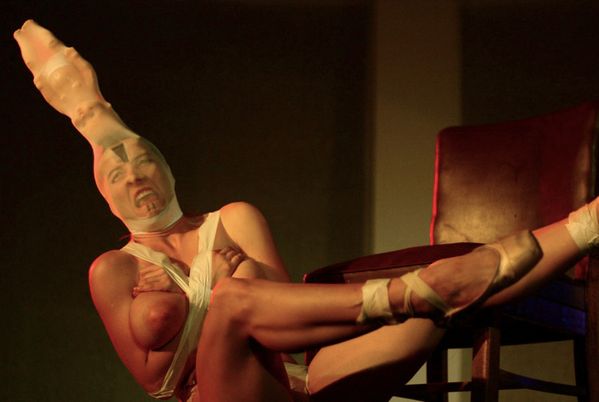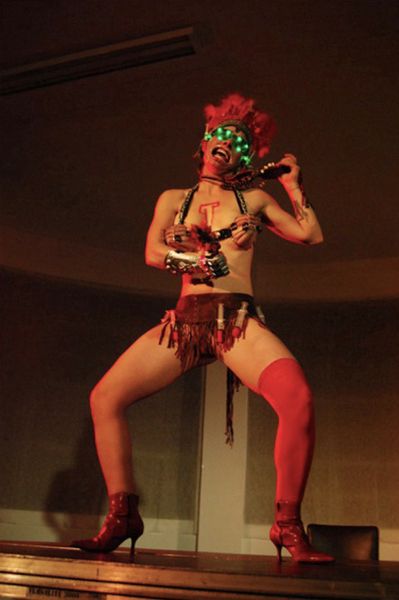10 acciones psicomagicas contra la violencia @ La Pocha Nostra. 2009. Bogota + entretien G. Gomez-Pena
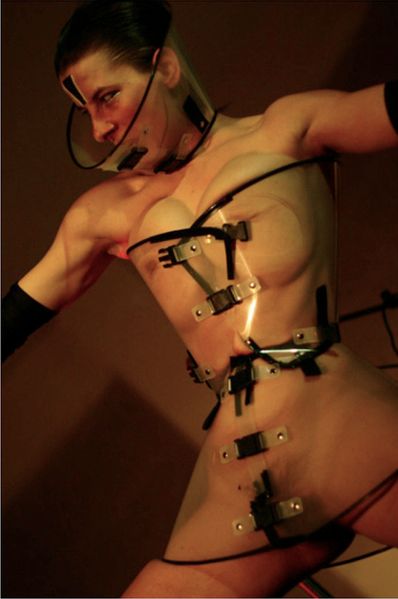
- LA POCHA NOSTRA, 10 acciones psicomagicas contra la violencia, 2009, Bogota.
VII encuentro of the Hemispheric Institute of Performance and Politics. Bogota, 2009. The performance was part of a double-bill: Album Doble: Dos Performances simultaneos
a) Sin titulo (Bogota, 2009), Tania Bruguera
b) 10 Acciones Psicomagicas contra la Violencia, Gomez-Pena & Dani d’Emilia.
Photo. Marlère Ramirez-Cancio/Cristhian Avila/Julio Pantoja
(Guillermo GÓMEZ-PEÑA - Entretien avec Gabriela Salgado, 14 mars 2012. The Forbidden Body: Notes on the Latin American Live Art Scene/Art Practical)
http://www.artpractical.com/feature/the_forbidden_body/
Consulté le 02/09/2014.
Part chronicle, part conversation, this hybrid text is part of an ongoing dialogue between long-time friends and collaborators, the Mexican performance artist Guillermo Gómez-Peña and the Argentine curator Gabriela Salgado. An earlier version of this text was published in the program for the 2012 New Territories International Festival of Live Art, February 27 to March 24, 2012.
« Postcards from the south
The indigenous performance artist Amapola Prada walks nude along one of Lima’s busiest avenues. She is menstruating. With her blood dripping down her legs, she leaves tiny printfoots. People are transfixed by her dreamlike image. No one dares to touch her or offend her. The magic of performance protects her.
Far away to the north, in Mexico City, another young female performance artist carries out a similar ritual action: to express her support for a student insurrection, Ema Villanueva walks nude the 46-kilometer-long avenue of Insurgentes. She asks the passersby to write their opinions about the student revolt with felt pens on her body. No one touches her inappropriately. By the time she finishes her walk, her body is a billboard of citizen opinion.
In the southern part of the continent, Julia Antivilo hitchhikes with truckers from Santiago de Chile to Buenos Aires. She is protected by her artwork: an elaborate chastity belt, an electrified bustier, and a hidden blade and video camera. Her goal is the prove that women are in the most danger in domestic realms and not in public spaces.
These powerful women have created a different kind of live art, defying the dangers and dilemnas that women experience in their respective countries. And none of these brave performance journeys were funded. While these artists performed discreet and fierce projects in Latin America, their peers in the United States were busy writing grants and rehearsing. »
Mapping Some Differences Between North and South
Gabriela Salgado : Which are some of the most obvious differences you encounter when working in Latin America versus the U.S.?
Guillermo Gómez-Peña : U.S. performance is more carefully packaged for artistic consumption. Artists are more self-conscious of being current and accepted. The field is much more professionalized and Darwinian. If you don’t constantly produce brand-new original projects, you are immediately exiled to oblivion. Performance art in Latin America is more about a lifetime process and less about currency and production values. In our (Latin American) countries, there is a lot of improvisation, trading of favors, and self-production. Artists must be extremely resourceful to make up for the lack of ongoing institutional and infrastructure support. And you: what differences have perceived on your trips?
GS : I think that, in wider terms, in Latin America there still reigns a certain precariousness in the so-called cultural industries, whereby the work of museum curators, musicians, visual and performance artists, dancers, and others is almost seen as philanthropic in virtue of their symbolic contribution to society. It is as if we should not demand to be paid for our work but be responsable for sustaining the whole system with sacrifices. On the other hand, in Europe the concept of cultural industries that was developed in the last decade promoted the professionalization of the sector to the extent that it created too many managerial jobs that have nothing to do with creativity and take away a large part of the allocated budgets. This funding structure has allowed politics to be interwined more effectively with the field through managerial control, in a parasitical and self-destructive manner. However, that model of investment in art has just been ressessed, and the implemented cuts are justified with arguments that reflects a mentality typical of the far right. In Holland, for instance, some of the discourses that have recently emerged in relation to arts funding evoke toxic notions such as the alliance of artists and intellectuals with the political left and their responsibility in relation to the ‘‘problem’’ of immigration.
With funding cuts spreading across the northern hemisphere, putting educational, social and cultural structures at risk for the first time in decades, the fear of (economic) uncertainty rises among artists and intellectuals whose livehoods depend largely on the grant system.
Here in the (southern hemisphere), our training – to (withstand) the irregularities of improvised policies, the corruption inherited from colonization, and the uncertainty of chaos always lying in wait around the corner – has provided each citizen with a thick skin that in times of uncertainty becomes extremely useful. Resourcefulness and courage make artists, intellectuals, and the population at large more resistant to the challenges of history.
GG-P : True. When my U.S. colleagues ask me if I am afraid on the financial crisis facing the art world, I tend to answer, ‘‘It’s never been different for Chicanos and Latin Americans. In fact, we were born and raised under crises. It’s no big deal.’’ The funds that Latin artists use to create their performance projects often come from complementary jobs, odd jobs. It’s called double- or triple-production. The performance artist Cesar Martinez teaches conceptual art, writes, and is studying to become a chef. Fernando Llanos runs a bar, writes books, and curates video festivals. He is currently making a feature-length movie. In the U.S., things have been quite different. There, my artist colleagues survive largely from grants, commissions, and past-time academia. And, with a few exceptions, this makes for a much slicker yet tamer type of work… but things may change soon. The collapse of the economy will inevitably level the working conditions in the immediate future.
GS : What about the legal constraints you experience working on both sides of the border?
GG-P : At the risk of generalizing, Latin American performance artists are not as constrained by law and prohibitions. It’s a visceral anti-colonial and anti-authoritarian attitude. We profundly distruct government institutions and legal structures. We hate the police and the army. We have no heroic narratives of law enforcement like in the U.S. In my experience, live artists preparing risky actions rarely ask for permission from the fire or public health inspectors, much less from the police. We just do it; and when we go to the streets, we do it at our own risk. Despite the fact that the Latin American streets are much more dangerous, people in the streets tend to be more open and accepting of deviant behavior than, say, people in the highly policed streets of the U.S. or Western Europe. I’ve seen some of the wildest voluntary and involuntary performance art pieces in the streets of Mexico City. An indigenous activist group, La Coordinadora de los 400 Pueblos, often stages nude protests in Mexico City. To suddenly encounter hundreds of nude indigenous bodies, from all ages, walking in silence across the city or standing nude on pedestals as human sculptures around the zocalo (the central plaza) is a very intense experience. This is not your typical avant-garde action. Their frail indigenous bodies are covered with colonial scars.
GS : In the U.K. for instance, legal prohibitions are generally tied to the obsession with conditions of health and safety in the public space. I have a direct experience of this through my work with artists as Cildo Meireles, whose installations provoke a strong physical interaction with materials that can sometimes be dangerous to the public, like broken glass or vast amounts of thread on the ground. The emotional and intellectual tensions that Meireles produces with these associations of body and matter are comparable to what live artists do in their work. This, in my view, is indirect censorship: by being subject to the regulations dictated by health and safety officers in museums, the work risks to losing its impact. It is fenced; its wings are cut down to avoid danger. All this is product of a culture that fears legal action, a very U.S. obsession. In Latin America, I have seen callousness in dealing with materials and dangerous substances in museums, which has in turn produced a freedom of action for artists to experiment.
GG-P : Complicated issue, qué no? In the U.S., political correctness in indirect collaboration with the puritan culture of fear imposed by the far right has created a rarified context for performance artists, who are constantly tiptoeing around issues of gender, race, and power – constantly self-censoring themselves. Artist s are always in fear of losing a grant or not getting invited back (to an arts institution). Since September 11, North American cultural institutions have become strangely fearful and quiet. The most transgressive work that my troupe has created in the past eight years can only performed in Latin America or Europe. Mapa/Corpo was banned in the U.S. for four years, and our new performance, Psycho-Magic Actions for a World Gone Wrong, still hasn’t been performed in the U.S.. It’s quite a dilemna for us.
GS : As a curator, I also feel prey to that dilemna. I sense that there is more space for radical thinking in South America at the moment, although accompanied by a still insufficient funding structure to support advances in the field. There is only room for hope that the situation will change.
The ‘‘Other’’ Live Art Worlds
GG-P : The evolution of performance art or live art (as it’s known in the U.K.) in Latin and indigenous America has responded to dramatically different art historical and sociopolitical factors. With the exception of a handful of names that have been singled out by the members of the exclusive club of the self-proclaimed international art world – mostly privileged artists in ongoing dialogue with their European and New York peers – the majority of Latin American practitioners remain a mystery to European and U.S. artists and art audiences. Why?
GS : The question of unwritten history is central to this invisibility. The history of art written by Northern historians for universal comsumption is incomplete, biased, Eurocentric, largely white, and highly prejudiced. Moreover, the notion of international art and its assumption of sameness are both rooted in outdated notions. As Walter Mignolo proposes, ‘‘The defense of the human sameness above human differences is always a claim made from the privileged position of identity politics in power.’’ He also argues the whiteness is presented alongside political theory as transparent, neutral, and objective, while color/blackness plus political theory becomes essentialist and fundamentlist* (*Walter Mignolo, I am here I Think: Globalization, Epistemic Disobedience And The De-Colonial Option, Durham, NC: Duke University Presse). Such identification with the white/Western cultural paradigms of modernity oblitaries most initiatives tending to underscore the multiplicity of Latin American societies and their complex relationship with other colonized cultures. In this sense, live art and other conceptual and activist practices with an impact on the social sphere are sites of resistance, as they are interwoven with political and sexual dynamite. In addition, there is also the question of consumption and parasitism that your work explores so often. The inclusion of the parallel developments of art – including performance, video, conceptual practices, music, litterature, and other manifestation of artistic activity outside the Europe/U.S. axis -– depends, as you have repeatedly pointed out, on trends. The latest fascination with post-Soviet Eastern European or Middle Eastern.
GS (cont.) : art scenes will soon be replaced by the next geographical chic.
Another layer of misunderstanding is added by the fact that as the history of those contemporary expressions is unknown, everything seems to float in a vacuum, propitiating the validation of the aesthetically or conceptually familiar, to the detriment of the specificity of those practices.
GG-P : There are other political factors that contribute to this invisibility. With the events of September 11, Latin America disappeared overnight from the map (of Western culture). The U.S. and Canada closed their borders to their continental neighbors and engaged in a policy driven by paranoid nationalism, cultural isolationism, and xenophobia. Their panic-stricken policies were easily justified by the narrative of an endless war on terror. While this was taking place, with the exception of Colombia and Mexico, Latin America moved to the left and stopped thinking of the U.S. as a major cultural reference and developed many strong voices and places in the live arts. In the past ten years, an exciting live art movement has emerged out of Mexico City, Oaxaca, Lima, Bogota, Cali, Rio de Janeiro, Sao Paulo, Buenos Aires, Cordoba, and Santiago, to name a few places. Most of these rebel milieus are led against all odds and with very little funding by women and gay artists.
GS : But there is a serious communication problem between these milieus.
GG-P : Partly due to Western ethnocentrism and partly due to the fact that there are no formalized communication channels, networks, or magazine between North and South America, these multiple live art works remain invisible and indifferent to one another. And when Latin American artists convene, the meetings are always brokered by the North. Northern impresarios, curators, and theorists often perform the role of ventriloquists and interpreters of difference. Paradoxically, because of this lack of direct communication between countries in the Americas, many of these live artists still don’t know one another in person. I have attended myriad gatherings in Los Angeles, New York, Quebec, London, Paris, and Berlin where I get to hang out with artists from my own continental neighborhood for the first time. It’s bizarre. Even the Latin American biennials devote very little space to performance. The only active network coordinated and theorized by Latin Americans and located throughout the continent is the Instituto Hemisférico de Performance y Politica.
GS : The prominent academic Néstor Garcia-Canclini proposed in a recent public discussion during the Mercosur Biennale (in Porto Alegre, Brazil) that events such as biennials of the South should invite Northern platforms to contemplate us, to summon the North Americans in order to invert the (role of) accessory historically allocated by them to us, whereby we were always invited to their parties. To invert the map, taking as inspiration the prescient Joaquin Torres Garcia’s drawing from 1936, to make our North the South --– that is the question.
GG-P : True. As diasporic Latinos operating from North America, our task is to occupy an alternative and more inclusive cartography, to occupy a fictional center, and to push the dominant North to the margins, treating it as exotic and unfamiliar. Fortunately there are enough border artists and intellectual coyotes (smugglers) with a bifocal understanding of these inter- and transcultural relations. These practitioners who are constantly migrating on their own volition, both within their own countries and outside, perform the role of informal diplomats and translators. And there is a lot to translate besides the language difference. The politics of the human body also needs to be translated.
The Terminological Wars
GG-P : You are opening Pandora’s box. The term performance is quite controversial in Latin America. Many artists consider it a cultural imposition and propose other terms such as arte accíon. Others prefer to reappropriate (and Spanishize) the term, calling it performa (Felipe Ehrenberg) or performancia. Rocio Boliver (a.k.a. La Congelada de Uva) prefers to call it performear(se), alluding to the act of pissing on your audience; the Mexican artist Maris Bustamante uses the word performantli, connecting the practice to its indigenous traditions; whereas César Martinez chooses to call himself artisto inter-indisciplinado, a hard-to-translate term that evokes both interdiscipline and untamable. Lately my troupe prefers to call what we do acciones psicomágicas, inspired by Alejandro Jodorowski.
The fact that the word performance does not quite match the multiple live art practices of our countries reveals the inherent cultural differences in live art production between North and South America.
GS : How appropriate to evoke Jodorowski in this moment of deep social and historical illness! Acciones psicomágicas are highly desirable in the current situation; much healing and inspiration are needed to challenge the established politics of greed and destruction. Students in Santiago de Chile, workers and the unemployed in New York, and those in Greek and Spanish towns are developing their actions in the streets. It is only natural that artists join them with the weapons of their imagination.
The Border Zone, a Territory of Ongoing Misunderstanding
GG-P : Since the ‘80s, the theories of cultural relativism generated by radical anthropologists and so-called multicultural theorists have informed academic discourse but not always art discourse. Despite the collapse of the Global Project in early 2000, the much-touted international art world still thrives on the mythology that the artistic cartography is borderless, and we often have to remind the Northern art curators and impresarios that intellectual discourse is simply not, and has never been, universal or international. Postmodern, feminist, queer and postcolonial discourses have had very different evolutions and dynamics in Latin America and are often connected to local civic and activist movements that emerge out of (each) country’s historical specificities. Now, given the profound ignorance of the North, what can Latin American performance artists do when crossing a cultural border into the so-called First World? This is the ultimate challenge for us: to relay in a symbolic body language capable of holding up the semiotic breakdown, or at least of putting it in evidence. If we don’t embrace this challenge, we are risk of being exoticized and misunderstood.
GS : I remember when your company, La Pocha Nostra, performed in London’s Tate Modern during the week of Iraq Invasion (March 2003). The atmosphere was very changed. A few moments of that emsemble of dioramas remained in my memory as crucial expressions of how an image performed by an artist with his or her body can unleash suppressed feelings and give voice to deeply seated fears and desires in the audience. I remember in particular a middle-aged Arab lady who came to the gallery holding a U.S. flag, with the initial intention of setting it on fire. After consulting with you, she considered that not only being in a public museum presented a liability for such an act but also, as an Arab woman, she would become prey to the antagonism that the politics of paranoia had perpetrated at that time. After a long discussion with you, she opted for something more poetic: she laid the flag on the ground and performed a ritual dance by stepping on it repeatedly, with both grace and anger.
GG-P : I remember. That was a dangerous ‘‘border moment.’’ And we were lucky to be able to solve it. But sometimes we fail and are misunderstood. I remember when La Congelada de Uva was invited for the first time to a Hemispheric Institute gathering in New York, she presented her amazing piece, Close your legs!, in which, dressed as a nun, she inserted a baby Jesus into her vagina, sewing her lips with thread. She outraged the New York intelligentsia, who failed to understand the weight that Catholicism has had on Mexico’s perception of women. Often humor is a formidable border. When the mexican artist César Martinez spent four years in Madrid, the Spaniards had a love/hate relationship with his performance work. They loved his wild aesthetics but hated his sense of humor. They failed to understand that you can be both highly conceptual and extremely funny. It’s a Mexican thing. I myself have had an ongoing debate with Boris Nieslony from Black Market International, who perceives my symbolic and highly stylized acts of violence at face value, regarding them as authoritarian, and my kitsch aesthetics as inauthentic. i have had to remind him that artifice and style are important for a culture (Chicano) that is under siege on a daily basis. We need to engage in a serious debate about these cultural misunderstandings. Which other issues regarding the North/South interface in live art do you feel need to be addressed?
GS : I would like to address this very crucial problem of translation. My question would be: how effective is it in the cultural field? Can we consider the border between different approaches to humor without affecting the impact of the message? But humor is of course not the only barrier; prejudice is even more difficult to cross. I remember the ideological borders you came into contact with Argentina, when performaing The Couple in the Cage with Coco Fusco in 1992. She wrote about the Argentine art milieu being very insensitive to your representation of indigenous people, as they saw themselves free from the concern of colonization. This was such a cynical pretense! After five hundred years, the country is still bloody with the multiple genocides of indigenous people since the arrival of the conquistadores, and to this day their human rights to land, language,, and a dignified life are not granted.
GG-P : What kind of work interests you lately, in the terrain of live art?
GS : The interface between the field of live art and activist performative actions is something that I recall us discussing for a long while. Once, tou mentioned a very moving civic action that took place in Mexico’s Zocalo Square. The image has remained in my mind all these years. You said that thousands of indigenous Mexicans (congregated) in the square, drank lots of water, and silently urinated at the same time, as an act of protest. How powerful that must have been!
GG-P : That was La Coordinatora de los 400 Pueblos! What about the current international occupation movement inspired by the Arab Spring and the Spanish Indignados?
GS : What I see is that – with the current confusion in relation to what seems to be a global political shift – social movements, indigenous activists, and the unemployed are deploying strategies of intervention that on a few occasions make use of aesthetic and poetic signs normally associated with art.
GG-P : With the severity of the current crisis and citizens occupying the streets of hundreds of cities worldwide, museums and major cultural institutions seem to be completely out of touch. This context offers us the possibility to begin new critical conversations regarding the multiple existing gaps not just between the North and South American live art milieus but also between the new streets and the future cultural organizations that have to catch up. Everyone I know is currently embarked on a radical process of soul-searching and reinvention. »
